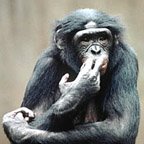Looks a scream, hang him on your wa-a-all.


Last week I visited the Andy Warhol exhibition, showing at the National Galleries of Scotland as part of the Edinburgh Festival (loyal readers will recall that last year's blockbuster was Ron Mueck).
I didn't have too much interest in Warhol previously...some good ideas, sure, but I'd got the idea. Or so I thought. In fact, we weren't going to go in at first (we were headed for the Picasso ceramics at the Museum for Scotland), but the queue was short and it was a spur of the moment thing.
I was blown away! I got more out of it than I have from an exhibition in many a year. here's some ramblings.
Warhol was the master of praxis. Just do something, and work out what it is afterwards. Keep churning out repeated images and new ideas will emerge. Say a starlet is terrific and It Shall Be So. Portray yourself as an artistic genius and things will happen. Repetition was obviously his Famous Big idea, but he did all sorts of exciting things with it:
- The Brillo pads and soup cans - in an industrialised, mass-market era, artifice has no value. The artefact becomes art. The trick is to continue to make art at a detached distance from the product.
- Jackie O. (This sort of thing - except with the images more mixed up). It took a while to realise that there were only three separate images, combined in various enlargements. What he's done here is added a time dimension - cf Picasso's 4-dimensional paintings. But he's added a televisual element for the media age: it's not a linear portrait, but a series of snatched glimpes of a public persona beamed intensively into living rooms over a period of intense interest. So it also adds multiple perspectives - the same image of a fixed event, viewed repeatedly by different people and/or the same person, over time - a blurring of time and viewpoints.
- His death paintings - stunning use of silk screen and silver nitrate photography to add noise to images, making the viewer work to draw out the content. In a version of this one (scroll down to Green Car Crash) it comes as a shock that the impaled victim is not the first thing we notice. A version of this has the image repeated, in one repetition with a lot of visual noise. The shock comes when one realises that a faint blur in the corner is the falling figure. (And again - it says something about time: Before and After). In another, one gradually realises that a hospital scene shows a baby being delivered by Caeserean section.
- Skull Paintings. Screen print on heavily impasto'd paint, lending subtle variations to each reproduction and making each one fresh.
- Screen tests. Films to be viewed as portraits. What is a film but a stream of still photos? (I had my own screen test done).
- Stitched photos. He's take four identical B&W photos and stitch them together (he left the the ends of the thread visible). When you look at them, you realise that you're focusing on something different in each repetition. It also turns out that he was a master of composition.
I could go on - but better not. I'll leave you with some children playing with his iconic 'Silver Clouds'.


1 comment:
It's rather cool that a spur of the moment decision ended up so satisfying. And I am now much more enlightened about the depth of Warhol's work - thanks for that.
Did you get to see the Picasso ceramics too?
Post a Comment